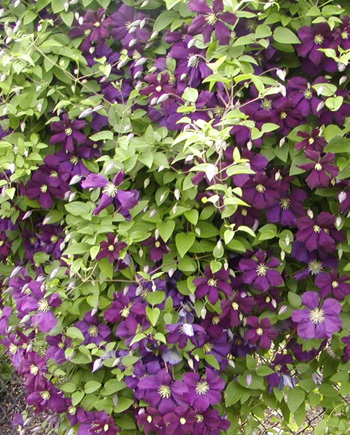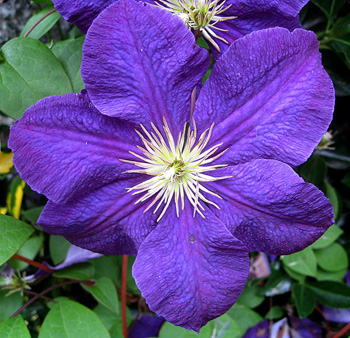Contents:
Common Names | Parts Usually Used | Plant(s) & Culture | Where Found | Medicinal Properties
Uses | Formulas or Dosages | Warning | Bibliography
Scientific Names

- Clematis virginiana L.
- Buttercup family
Common Names
- Clematis
- Virgin’s bower
Parts Usually Used
Twigs and leaves, flowers
Back to Top

Description of Plant(s) and Culture
A woody climbing vine, its opposite, ternate leaves divided into 3 sharp-toothed ovate, acute, serrate leaflets. Its small, petalless flowers have 4 petal-like whitish sepals and bloom in leafy, cymose panicles during summer and autumn. The fruit is a feathery achene (a small, dry fruit with one seed which is attached to the ovary wall only at one point) which grows in prominent heads. These feathery plumes attached to the seeds.
Another variety: Native Americans used another plant (Clematis ligusticifolia) also called clematis and virgin’s bower. They used the leaves and bark as shampoo; at Fort MacDermitt, Nevada, the root was dried and powdered for use as a shampoo.
Back to Top
Where Found
Found along streambanks, bushes, thickets, wood edges, and fences in the eastern and central states of the United States. Nova Scotia to Georgia; Louisiana; eastern Kansas north to Canada.
Back to Top
Medicinal Properties
Diaphoretic (increases perspiration), diuretic, stimulant, vesicant (produces blisters).
Back to Top
Uses
An infusion of the leaves and flowers of virgin’s bower is said to relieve even severe headaches. For external use, this herb is sometimes combined with other plants to make ointments or poultices for sores, skin ulcers, and itching skin.
Back to Top
Formulas or Dosages
Infusion: steep 1 heaping tsp. of leaves and flowers in 1 cup water for 30 minutes. Take 1 tsp. 4-6 times per day.
Inhaling the fumes of the bruised root or leaves is said to relieve headaches (but I wouldn’t try it).
Back to Top
Warning
Virgin’s bower contains acrid substances which can cause severe skin irritation. Sensitive people can get dermatitis from handling the plant.
Virgin’s bower is toxic. Highly irritating to skin and mucous membranes.
Ingestion may cause bloody vomiting, severe diarrhea, and convulsions.
Use under medical supervision only.
Back to Top
Bibliography
![]() The Herb Book
The Herb Book, by John Lust, Bantam Books, 666 Fifth Avenue, New York, NY. copyright 1974.
![]() Back to Eden
Back to Eden, by Jethro Kloss; Back to Eden Publishing Co., Loma Linda, CA 92354, Original copyright 1939, revised edition 1994
![]() Indian Uses of Native Plants
Indian Uses of Native Plants, by Edith Van Allen Murphey, Meyerbooks, publisher, PO Box 427, Glenwood, Illinois 60425, copyright 1958, print 1990
![]() Eastern/Central Medicinal Plants
Eastern/Central Medicinal Plants, by Steven Foster and James A. Duke., Houghton Mifflin Company, 215 Park Avenue South, New York, NY 10000
 Taber’s Cyclopedic Medical Dictionary
Taber’s Cyclopedic Medical Dictionary, 15th Edition, F. A. Davis Company, 1915 Arch Street, Philadelphia, PA 19103
![]() Webster’s New World Dictionary
Webster’s New World Dictionary, Third College Edition, Victoria Neufeldt, Editor in Chief, New World Dictionaries: A Division of Simon & Schuster, Inc., 15 Columbus Circle, New York, NY 10023
